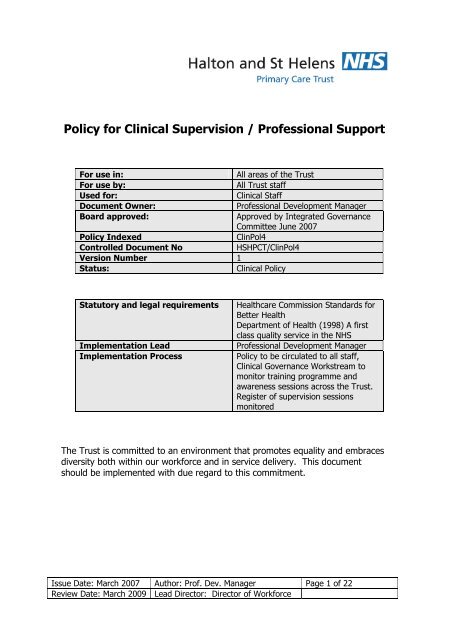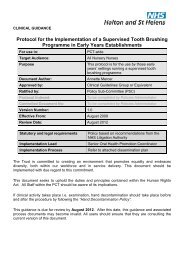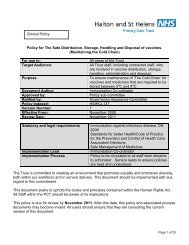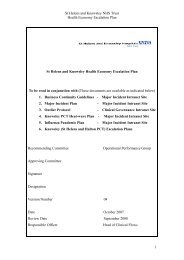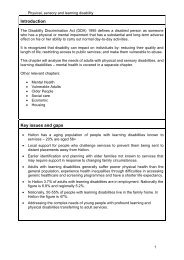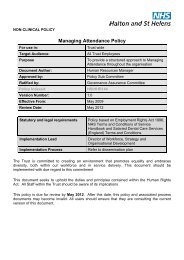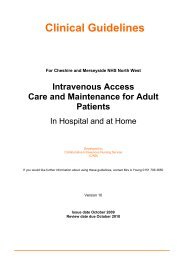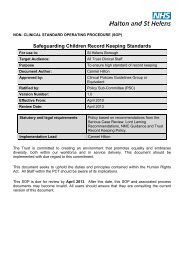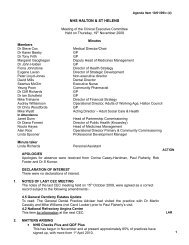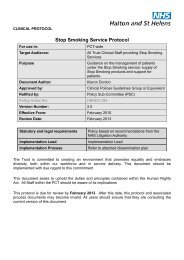Policy for Clinical Supervision / Professional Support - Halton and St ...
Policy for Clinical Supervision / Professional Support - Halton and St ...
Policy for Clinical Supervision / Professional Support - Halton and St ...
You also want an ePaper? Increase the reach of your titles
YUMPU automatically turns print PDFs into web optimized ePapers that Google loves.
<strong>Policy</strong> <strong>for</strong> <strong>Clinical</strong> <strong>Supervision</strong> / <strong>Professional</strong> <strong>Support</strong><br />
For use in:<br />
For use by:<br />
Used <strong>for</strong>:<br />
Document Owner:<br />
Board approved:<br />
<strong>Policy</strong> Indexed<br />
Controlled Document No<br />
Version Number 1<br />
<strong>St</strong>atus:<br />
<strong>Clinical</strong> <strong>Policy</strong><br />
All areas of the Trust<br />
All Trust staff<br />
<strong>Clinical</strong> <strong>St</strong>aff<br />
<strong>Professional</strong> Development Manager<br />
Approved by Integrated Governance<br />
Committee June 2007<br />
ClinPol4<br />
HSHPCT/ClinPol4<br />
<strong>St</strong>atutory <strong>and</strong> legal requirements<br />
Implementation Lead<br />
Implementation Process<br />
Healthcare Commission <strong>St</strong><strong>and</strong>ards <strong>for</strong><br />
Better Health<br />
Department of Health (1998) A first<br />
class quality service in the NHS<br />
<strong>Professional</strong> Development Manager<br />
<strong>Policy</strong> to be circulated to all staff,<br />
<strong>Clinical</strong> Governance Workstream to<br />
monitor training programme <strong>and</strong><br />
awareness sessions across the Trust.<br />
Register of supervision sessions<br />
monitored<br />
The Trust is committed to an environment that promotes equality <strong>and</strong> embraces<br />
diversity both within our work<strong>for</strong>ce <strong>and</strong> in service delivery. This document<br />
should be implemented with due regard to this commitment.<br />
Issue Date: March 2007 Author: Prof. Dev. Manager Page 1 of 22<br />
Review Date: March 2009 Lead Director: Director of Work<strong>for</strong>ce
CONTENTS PAGE<br />
Introduction 3<br />
What is <strong>Clinical</strong> <strong>Supervision</strong> 3<br />
Link between <strong>Clinical</strong> Governance <strong>and</strong> <strong>Clinical</strong> <strong>Supervision</strong> 5<br />
Why is <strong>Supervision</strong> Necessary? 5<br />
Trust responsibilities <strong>for</strong> <strong>Clinical</strong> <strong>Supervision</strong> 6<br />
Characteristics/Qualities of a <strong>Clinical</strong> Supervisor 6<br />
The Supervisor’s Role 6<br />
The Supervisee’s Role 7<br />
Models of <strong>Clinical</strong> <strong>Supervision</strong> 7<br />
Arrangements of <strong>Clinical</strong> <strong>Supervision</strong> in:<br />
Community Nursing 7<br />
Child Protection 8<br />
Midwifery 9<br />
Therapy & Dental Services 10<br />
<strong>Supervision</strong> Contract 10<br />
Register of Attendance 11<br />
Monitoring the Process 11<br />
References 12<br />
Appendices 13-22<br />
Issue Date: March 2007 Author: Prof. Dev. Manager Page 2 of 22<br />
Review Date: March 2009 Lead Director: Director of Work<strong>for</strong>ce
1. Introduction<br />
<strong>Clinical</strong> <strong>Supervision</strong> is the term used to describe a <strong>for</strong>mal process of<br />
professional support which should be seen as a means of encouraging selfassessment<br />
<strong>and</strong> analytical <strong>and</strong> reflective skills.<br />
<strong>Clinical</strong> <strong>Supervision</strong> can both empower <strong>and</strong> support those in practice, but only if<br />
it is developed by clinical staff <strong>and</strong> implemented through them, as the process<br />
relies on those who are actively working in practice <strong>and</strong> have current<br />
experience.<br />
<strong>Clinical</strong> <strong>Supervision</strong> involves a tripartite partnership between the Supervisor,<br />
Supervisee <strong>and</strong> the organisation. If any one of these fails to participate in, or<br />
actively sabotages <strong>Clinical</strong> <strong>Supervision</strong>, the supervisory process cannot be fully<br />
effective or demonstrably beneficial.<br />
There are benefits in <strong>Clinical</strong> <strong>Supervision</strong> to both the individual practitioner <strong>and</strong><br />
the organisation. It is a means whereby professional knowledge may be<br />
exp<strong>and</strong>ed <strong>and</strong> an underst<strong>and</strong>ing developed of individual client needs. The<br />
process facilitates the evaluation of the Practitioner’s interaction with the client<br />
<strong>and</strong> the rest of the Team to ensure that the best quality of care is provided.<br />
This policy has been developed to provide a strong framework around which<br />
the practice of <strong>Clinical</strong> <strong>Supervision</strong> can be enhanced within the Trust. It is<br />
hoped that they will support a variety of models of clinical supervision that have<br />
developed in accordance with local circumstances <strong>and</strong> staff development needs.<br />
This policy includes the basic principals of <strong>Clinical</strong> <strong>Supervision</strong> but are not<br />
intended to prepare an individual to take on either the role of Supervisor or<br />
Supervisee. A programme of a two-day workshop <strong>for</strong> supervisors <strong>and</strong> basic<br />
awareness training <strong>for</strong> supervisees is available to support the implementation of<br />
<strong>Clinical</strong> <strong>Supervision</strong> within all services.<br />
2. What is <strong>Clinical</strong> <strong>Supervision</strong><br />
The NHS Management Executive defined <strong>Clinical</strong> <strong>Supervision</strong> in 1993 as: -<br />
“… a <strong>for</strong>mal process of professional support <strong>and</strong> learning which enables<br />
individual practitioners to develop knowledge <strong>and</strong> competence, assume<br />
responsibility <strong>for</strong> their own practice <strong>and</strong> enhance consumer protection<br />
<strong>and</strong> safety of care in complex situations.”<br />
Bond <strong>and</strong> Holl<strong>and</strong> (1998) describe it as: -<br />
Issue Date: March 2007 Author: Prof. Dev. Manager Page 3 of 22<br />
Review Date: March 2009 Lead Director: Director of Work<strong>for</strong>ce
‘Regular, protected time <strong>for</strong> facilitated, in-depth reflection on clinical<br />
practice aimed to enable the supervisee to achieve, sustain <strong>and</strong><br />
creatively develop a high quality of practice through the means of<br />
focused support <strong>and</strong> development’<br />
<strong>Clinical</strong> <strong>Supervision</strong> is a collaborative dynamic process including the components<br />
of teaching <strong>and</strong> mentorship, which goes beyond a pastoral, nurturing role <strong>and</strong><br />
positively works towards ‘enabling’ the supervisee to:<br />
• Have time to engage in critical self-examination <strong>and</strong> reflection on<br />
practice.<br />
• Become more self aware<br />
• Identify practice issues <strong>and</strong> to consider approaches to practice based on<br />
evidence.<br />
• Consider the recipients of the service in terms of their perceptions of<br />
what is happening in their lives <strong>and</strong> in response to interventions.<br />
• Be challenged in a safe environment<br />
• Have the opportunity to consider their training <strong>and</strong> development needs.<br />
<strong>Clinical</strong> <strong>Supervision</strong> can be offered in terms of three different functions. Within<br />
any one supervision session the relationship can focus on just one of these<br />
functions or be a mixture of two or three different functions.<br />
• Formative (Educational)<br />
• Normative (Managerial)<br />
• Restorative (<strong>Support</strong>ive)<br />
• FORMATIVE – is about developing the skills, <strong>and</strong> underst<strong>and</strong>ing the general<br />
abilities of the supervisee. Developing an awareness of why <strong>and</strong> how<br />
interventions are used <strong>and</strong> exploring alternative strategies, ensuring that<br />
practice is evidence based.<br />
• RESTORATIVE – is a way of responding to supervisees as a consequence of<br />
them as individuals, working with people who have complex needs.<br />
Supervisees should be encouraged to reflect on ways in which they have<br />
been affected, <strong>and</strong> they may, as a result, relate differently to other people.<br />
• NORMATIVE – is related to the qualitative aspect of the work the supervisee<br />
undertakes. The qualitative aspect of supervision is concerned with issues<br />
related to equity <strong>and</strong> fairness to the people we work with, the organisation<br />
we work <strong>for</strong> <strong>and</strong> relate to. Normative or managerial supervision is not about<br />
making judgements on people <strong>and</strong> their work, but about highlighting areas<br />
<strong>for</strong> improvement <strong>and</strong> change of which the supervisee may not be fully<br />
aware.<br />
Proctor, B (1986) ‘<strong>Supervision</strong>: A Co-operative Exercise in Accountability’<br />
Issue Date: March 2007 Author: Prof. Dev. Manager Page 4 of 22<br />
Review Date: March 2009 Lead Director: Director of Work<strong>for</strong>ce
3. Link Between <strong>Clinical</strong> Governance <strong>and</strong> <strong>Clinical</strong> <strong>Supervision</strong><br />
<strong>Clinical</strong> Governance can be defined as:<br />
‘A framework through which NHS Organisations are accountable <strong>for</strong><br />
continuously improving the quality of their services <strong>and</strong> safeguarding<br />
high st<strong>and</strong>ards of care by creating an environment in which clinical<br />
excellence will flourish’. (DoH 1998). <strong>Clinical</strong> Governance is also the<br />
means ‘by which organisations ensure the provision of quality clinical<br />
care by making individuals accountable <strong>for</strong> setting, maintaining <strong>and</strong><br />
monitoring per<strong>for</strong>mance st<strong>and</strong>ards’. (DoH North Thames Regional Office<br />
1998).<br />
<strong>Clinical</strong> Governance places the responsibility <strong>for</strong> the quality of care on<br />
organisations <strong>and</strong> on individuals within organisations.<br />
Recent research evidence demonstrates (Butterworth T et al 1997) that <strong>Clinical</strong><br />
<strong>Supervision</strong> has an important role to play in the <strong>Clinical</strong> Governance agenda.<br />
By focusing on clinical work <strong>and</strong> skills development, through the effective use of<br />
<strong>Clinical</strong> <strong>Supervision</strong>, there is a well-developed system in place which supports<br />
some of the central requirements of <strong>Clinical</strong> Governance.<br />
Participating in clinical supervision in an active way is a clear demonstration of<br />
an individual exercising their responsibility under <strong>Clinical</strong> Governance. <strong>Clinical</strong><br />
<strong>Supervision</strong> should properly be seen as taking its place in a wider framework of<br />
activities that are designed to manage, enhance <strong>and</strong> monitor the delivery of<br />
high quality clinical services.<br />
4. Why is <strong>Supervision</strong> Necessary?<br />
To:<br />
• Review, reflect <strong>and</strong> receive guidance on casework.<br />
• Protect the patient / client.<br />
• Ensure competent practice <strong>and</strong> monitor <strong>and</strong> safeguard st<strong>and</strong>ards.<br />
• Identify, develop <strong>and</strong> share practice skills.<br />
• Review <strong>and</strong> reflect on clinical issues.<br />
• Reflect on critical incidents.<br />
• Decrease feelings of isolation <strong>and</strong> distress. Increase feelings of<br />
responsibility <strong>and</strong> commitment to improve client / patient care.<br />
• Keep a perspective on professional boundaries <strong>and</strong> to ensure that the<br />
boundaries in the practitioner / patient relationship are understood.<br />
• Express emotional or painful work- related feelings.<br />
• Ensure legal <strong>and</strong> ethical st<strong>and</strong>ards are maintained.<br />
Issue Date: March 2007 Author: Prof. Dev. Manager Page 5 of 22<br />
Review Date: March 2009 Lead Director: Director of Work<strong>for</strong>ce
4.1 Trust Responsibilities <strong>for</strong> <strong>Clinical</strong> <strong>Supervision</strong><br />
Training <strong>and</strong> <strong>Support</strong>:<br />
• Appropriate experienced Practitioners will be offered training to undertake<br />
the role of <strong>Clinical</strong> Supervisors.<br />
• Supervisors will receive <strong>Clinical</strong> <strong>Supervision</strong> themselves, either one to one or<br />
in a small group.<br />
• Formal support networks <strong>for</strong> <strong>Clinical</strong> Supervisors will be developed within<br />
each service.<br />
• The Trust acknowledges that Supervisors need a willingness <strong>and</strong><br />
commitment to fulfil the role.<br />
• Time will be allocated to attend <strong>Clinical</strong> <strong>Supervision</strong> meetings.<br />
4.2 Characteristics / Qualities of a <strong>Clinical</strong> Supervisor<br />
<strong>Clinical</strong> Supervisors will be experienced practitioners with clinical credibility who<br />
are able to demonstrate: -<br />
• Knowledge <strong>and</strong> application of reflective practice skills.<br />
• <strong>Professional</strong> maturity i.e. willingness, openness <strong>and</strong> confidence to challenge<br />
practice issues.<br />
• Underst<strong>and</strong> the issues concerned with personal accountability <strong>and</strong><br />
responsibility.<br />
• Good interpersonal skills.<br />
• A sound knowledge base in relevant practice field.<br />
4.3 The Supervisors Role is to:<br />
• Ensure protected time <strong>for</strong> each Supervisee to lay out issues in his / her own<br />
way.<br />
• Help Supervisees explore <strong>and</strong> clarify thinking, feeling <strong>and</strong> beliefs which<br />
underlie their practice.<br />
• Enable Supervisees to identify <strong>and</strong> discuss critical incidents <strong>and</strong> / or stressinducing<br />
aspects of their professional work.<br />
• Share experience, in<strong>for</strong>mation <strong>and</strong> skills appropriately.<br />
• Challenge practice which he / she perceives unethical, unwise or<br />
incompetent.<br />
• Challenge personal <strong>and</strong> professional blind spots which he / she may perceive<br />
in individuals or the group.<br />
• Be aware of the organisational contracts with he / she <strong>and</strong> the Supervisees<br />
may have with the employer <strong>and</strong> client in terms of <strong>Supervision</strong>.<br />
• Facilitate professional development.<br />
Issue Date: March 2007 Author: Prof. Dev. Manager Page 6 of 22<br />
Review Date: March 2009 Lead Director: Director of Work<strong>for</strong>ce
4.4 The Supervisees Role is to:<br />
• Identify practice issues with which he / she needs help <strong>and</strong> to ask <strong>for</strong> time<br />
to deal with these.<br />
• Become increasingly able to share these issues freely.<br />
• Contribute to reflective discussion.<br />
• Become more aware of the organisational contracts he /she is in with clients<br />
<strong>and</strong> the Supervisor or supervision group.<br />
• Respond to feedback from his / her Supervisor in a structured <strong>and</strong><br />
professional manner.<br />
• Participate in the process of ‘shared responsibility’.<br />
4.5 Models of <strong>Clinical</strong> <strong>Supervision</strong><br />
There are a variety ways of organising <strong>Clinical</strong> <strong>Supervision</strong>: -<br />
• One to one supervision with a supervisor from your own discipline<br />
• One to one supervision with a supervisor from a different discipline<br />
• Group supervision (shared supervision by teams). Group supervision can be<br />
uni-professional or multi-professional. The ratio of supervisor: supervisee is<br />
recommended 1:4/5. It is also recommended that if the group is larger, then<br />
consider the use of 2 supervisors or splitting the group.<br />
• Network supervision – a group of practitioners with similar expertise <strong>and</strong><br />
interests who do not work together on a day-day basis<br />
(Butterworth, T. 1995)<br />
5. THE ARRANGEMENTS FOR CLINICAL SUPERVISION IN:<br />
5.1 COMMUNITY NURSING.<br />
(District Nursing, Health Visiting, Practice Nurses <strong>and</strong> School Health Nurses,<br />
Family Planning Nurses <strong>and</strong> Nurse Clinicians) <strong>and</strong> specialisms i.e. MacMillan,<br />
Heart Failure.<br />
MODEL.<br />
The preferred model <strong>for</strong> <strong>Clinical</strong> <strong>Supervision</strong> in Community Nursing is group<br />
supervision. This can be undertaken as a multi-professional group or uniprofessional<br />
based on local circumstances <strong>and</strong> staff needs. Where there may be<br />
only one post or two within an area of practice, special arrangements need to<br />
be made on how to access clinical supervision. This may be linking into a multiprofessional<br />
group or seeking supervision outside of the Trust. One-one<br />
supervision is available <strong>for</strong> staff to access should the need arise. This model is<br />
beneficial to newly qualified/employed practitioners. It can be a continuum to<br />
preceptor ship.<br />
Issue Date: March 2007 Author: Prof. Dev. Manager Page 7 of 22<br />
Review Date: March 2009 Lead Director: Director of Work<strong>for</strong>ce
FREQUENCE.<br />
Recommendations from the evaluation study (Porter, I. 1998) were 4-6 times<br />
per year <strong>and</strong> hence supervision sessions need to take place.<br />
• Minimum 3 monthly<br />
• Maximum 2 monthly<br />
Each supervision session should be between 1-2 hours in length with agreed<br />
start <strong>and</strong> finish times.<br />
The Nurse manager from each of the services will arrange bi-annual meetings<br />
with the <strong>Clinical</strong> Supervisors within their service. The purpose of these<br />
meetings will be to identify:<br />
• Issues relating to the management of supervision, i.e nonattendance,<br />
lack of time, group size, group dynamics.<br />
• Areas where <strong>Clinical</strong> <strong>Supervision</strong> is not happening <strong>and</strong> the<br />
reasons <strong>for</strong> it.<br />
• Training needs of <strong>Clinical</strong> Supervisors.<br />
• Tangible benefits of clinical supervision to be fed through<br />
<strong>Clinical</strong> Governance Committee<br />
It is the responsibility of the Nurse Managers <strong>for</strong> ensuring that new starters are<br />
linked into clinical supervision. Supervisors will facilitate this process <strong>and</strong> will be<br />
available to support supervisors who are experiencing particular difficulties with<br />
the role of “supervisor”.<br />
It is the responsibility of the Nurse Managers to keep a record of all staff within<br />
their service <strong>and</strong> how they access clinical supervision. It should be m<strong>and</strong>atory<br />
<strong>for</strong> all nursing staff to attend clinical supervision.<br />
5.2 CHILD PROTECTION.<br />
<strong>Supervision</strong> of Health Visitors / School Health Nurses in Child Protection will<br />
take place with one of the Child Protection professionals from the <strong>Halton</strong> / <strong>St</strong><br />
Helens office as appropriate <strong>and</strong> will aim to give Health Visitors / School Health<br />
Nurses the opportunity to discuss freely <strong>and</strong> openly cases about which they<br />
have particular concerns.<br />
Child Protection <strong>Clinical</strong> <strong>Supervision</strong> will be on a one-to-one basis <strong>and</strong> will be<br />
planned individually with each Health Visitor / School Health Nurse.<br />
<strong>Supervision</strong> merges with training <strong>and</strong> will include in<strong>for</strong>mation giving <strong>and</strong><br />
guidance. Newly qualified <strong>and</strong> newly appointed staff will be introduced to local<br />
policies <strong>and</strong> procedures <strong>and</strong> the continuing training needs of practitioners will<br />
be assessed.<br />
Issue Date: March 2007 Author: Prof. Dev. Manager Page 8 of 22<br />
Review Date: March 2009 Lead Director: Director of Work<strong>for</strong>ce
Other professionals <strong>and</strong> agencies will have access to the senior Nurse Child<br />
Protection <strong>for</strong> advice <strong>and</strong> in<strong>for</strong>mation.<br />
5.3 STATUTORY SUPERVISION OF MIDWIVES<br />
<strong>Supervision</strong> of Midwives <strong>and</strong> midwifery practice is a statutory responsibility<br />
established in the first Midwives Act 1902.<br />
It is written into the Midwives Rules <strong>and</strong> <strong>St</strong><strong>and</strong>ards (NMC 2004).<br />
Supervisors of Midwives<br />
• Protect the public – are advocates of high st<strong>and</strong>ards of care <strong>for</strong><br />
mothers <strong>and</strong> babies<br />
• <strong>Support</strong> midwives in their practice – a mechanism of support <strong>and</strong><br />
guidance to every practising midwife<br />
• Investigate <strong>and</strong> address issues of poor practice – through training,<br />
updating, mentorship <strong>and</strong> support, while seeking to achieve a<br />
positive learning experience <strong>for</strong> midwives.<br />
Organised through the <strong>St</strong>rategic Health Authorities, supervision is region-led by<br />
the Local Supervising Authority (LSA) through the LSA Midwifery Officer, <strong>and</strong> a<br />
team of Link Supervisors of Midwives.<br />
There is a yearly inspection of midwifery practice locally by the LSA Officer,<br />
when she meets midwives <strong>and</strong> service users, <strong>and</strong> measures local practice to<br />
ensure achievement of agreed st<strong>and</strong>ards set by the LSA.<br />
Prospective Supervisors must be experienced clinical midwives with a minimum<br />
of 3 years experience as a practising midwife.<br />
Requirements of <strong>Supervision</strong><br />
The maximum recommended ratio of midwives to Supervisor is 15 to 1. An<br />
annual Supervisory audit meeting takes place between each midwife <strong>and</strong> her<br />
Supervisor which includes checks on: -<br />
• Drugs<br />
• Diaries<br />
• NMC Guidance booklets<br />
• Record Keeping<br />
• Personal Delivery Register<br />
Discussion also takes place around: -<br />
• A reflective practice incident – all midwives are encouraged to use<br />
reflection as a learning tool<br />
• Any issues that midwives feel affects practice<br />
Issue Date: March 2007 Author: Prof. Dev. Manager Page 9 of 22<br />
Review Date: March 2009 Lead Director: Director of Work<strong>for</strong>ce
• Training <strong>and</strong> updating evidence is reviewed <strong>and</strong> advice given<br />
• A plan <strong>for</strong> further development <strong>for</strong> the <strong>for</strong>thcoming year is<br />
encouraged <strong>and</strong> agreed between midwife <strong>and</strong> Supervisor<br />
Locally, midwives have an opportunity annually to choose which Supervisor<br />
they are allocated to<br />
There is a 24 hour Supervisor on-call rota, so that midwives can contact a<br />
Supervisor <strong>for</strong> advice <strong>and</strong> support any time of the day or night.<br />
5.4 THERAPY & DENTAL SERVICES.<br />
Each Service has an agreed structure <strong>for</strong> implementing <strong>Clinical</strong> <strong>Supervision</strong>.<br />
Group <strong>and</strong> one to one sessions are the models used. Frequency ranges from:<br />
Minimum<br />
Maximum<br />
3 monthly<br />
1 monthly<br />
Supervisors will be either peers or a senior grade clinically to the supervisee. All<br />
<strong>Clinical</strong> Supervisors will have undertaken the relevant training. The managers<br />
will have the responsibility to ensure that supervision takes place.<br />
Arrangements <strong>for</strong> <strong>Supervision</strong> <strong>for</strong> Supervisors <strong>and</strong> other most senior clinicians<br />
will be arranged outside the Trust, if no appropriate peers are available within<br />
the organisation. This may occur in specialist services.<br />
Bi-annually supervisors will meet with therapy <strong>and</strong> dental managers to feed the<br />
outcomes of clinical supervision into the management agenda. This will <strong>for</strong>m<br />
the basis of a report outlining the impact of <strong>Clinical</strong> <strong>Supervision</strong> <strong>and</strong> the<br />
changes in practice occurring as a result.<br />
6. SUPERVISION CONTRACT (Appendix One).<br />
It is important to have a clear working arrangement <strong>for</strong> every supervision<br />
relationship, <strong>and</strong> every supervision relationship must have its own contract.<br />
The <strong>Supervision</strong> Contract should be agreed <strong>and</strong> signed by both the supervisees<br />
<strong>and</strong> supervisor.<br />
The <strong>Supervision</strong> Contract should include the following:<br />
1. Name of Supervisor <strong>and</strong> Supervisee<br />
2. Frequency, length <strong>and</strong> venue of supervision sessions; if possible, plan the<br />
supervision sessions <strong>for</strong> the <strong>for</strong>th-coming year.<br />
3. Confidentiality clause. The limits of confidentiality must be specified in the<br />
contract. The group need to be aware of when confidentiality will be broken<br />
<strong>and</strong> <strong>for</strong> what reasons. The confidentiality clause to be used in all supervisory<br />
contracts is:<br />
Issue Date: March 2007 Author: Prof. Dev. Manager Page 10 of 22<br />
Review Date: March 2009 Lead Director: Director of Work<strong>for</strong>ce
“All issues discussed will be in confidence, unless there is anything<br />
disclosed that affects the well being of the supervisee or are detrimental<br />
to patients, professional practice, the Team or the organisation.”<br />
4. Documentation of issues discussed within the supervision session. There will<br />
be a requirement <strong>for</strong> evidence to support the evaluation process of clinical<br />
supervision. Supervisors will be expected to keep agenda / action notes of<br />
the topics covered <strong>and</strong> the outcome. This in<strong>for</strong>mation will be able to support<br />
the monitoring <strong>and</strong> audit process.<br />
5. The supervision contract should have a date agreed <strong>and</strong> a review date.<br />
7. REGISTER OF ATTENDANCE (Appendix two)<br />
A register of attendance must be kept by the supervisor. A copy of the register<br />
should be sent to the identified manager <strong>for</strong> the service, who is supporting<br />
clinical supervisors. Reason <strong>for</strong> non-attendance by supervisees must be<br />
recorded.<br />
Whilst is appreciated that supervisees will not be able to attend all sessions,<br />
<strong>Clinical</strong> <strong>Supervision</strong> is not considered as an option <strong>and</strong> non-attendance or<br />
difficulties with the supervisory relationship should be brought to the attention<br />
of management.<br />
Supervisors should be supported by management in emphasising the<br />
importance of any “contractual/charter” agreement to those practitioners who<br />
are non-attendees or af<strong>for</strong>d <strong>Clinical</strong> <strong>Supervision</strong> a low priority.<br />
8. MONITORING THE PROCESS.<br />
A database which contains the details of all clinical supervisors, their<br />
supervisees, frequency of sessions <strong>and</strong> attendees will be maintained by the<br />
manager of the Service. This will necessitate the return of a copy of the<br />
supervision register being <strong>for</strong>warded to their manager. This would enable the<br />
Trust to audit the uptake of clinical <strong>Supervision</strong> across the organisation. A<br />
central database will be kept in clinical governance with a list of supervisors. It<br />
is the managers responsibility to in<strong>for</strong>m clinical governance of changes to the<br />
list.<br />
<strong>Clinical</strong> Supervisors will be responsible <strong>for</strong> producing a brief report on the<br />
process <strong>and</strong> outcomes of their clinical supervision sessions. A series of “tools”<br />
have been developed to support this process (Appendix Three). The “tools” can<br />
be used to maintain the focus of <strong>Clinical</strong> <strong>Supervision</strong> <strong>for</strong> the supervisees <strong>and</strong> by<br />
the <strong>Clinical</strong> Supervisor to facilitate clinical issues being raised at supervision.<br />
The clinical supervisors report back sheet should be sent back to the clinical<br />
supervisor’s manager every six months <strong>and</strong> a copy sent to the professional lead<br />
within the Trust.<br />
Issue Date: March 2007 Author: Prof. Dev. Manager Page 11 of 22<br />
Review Date: March 2009 Lead Director: Director of Work<strong>for</strong>ce
An annual report with an overview of the outcomes of <strong>Clinical</strong> <strong>Supervision</strong> will<br />
be made available to the <strong>Clinical</strong> Governance Committee.<br />
Issue Date: March 2007 Author: Prof. Dev. Manager Page 12 of 22<br />
Review Date: March 2009 Lead Director: Director of Work<strong>for</strong>ce
REFERENCES FOR CLINICAL SUPERVISION<br />
Butterworth T (1994) Preparing to take on clinical supervision. Nursing<br />
<strong>St</strong><strong>and</strong>ard 8(52): 32-34.<br />
Butterworth T (1996) Primary attempts at research-based evaluation of clinical<br />
supervision. Nursing Times Research. 1(2): 96-101.<br />
B<strong>and</strong> M Holl<strong>and</strong> S (1998) Skills of <strong>Clinical</strong> <strong>Supervision</strong> <strong>for</strong> Nurses Open<br />
University Press.<br />
Department of Health (1998) A first class service quality in the new NHS. HMSO<br />
London.<br />
NMC (2002) Midwives Rules <strong>and</strong> <strong>St</strong><strong>and</strong>ards<br />
Proctor B (1986) <strong>Supervision</strong> - A Co-operative Exercise in Accountability.<br />
Wright H (1989) Group Work perspectives <strong>and</strong> practices.<br />
Issue Date: March 2007 Author: Prof. Dev. Manager Page 13 of 22<br />
Review Date: March 2009 Lead Director: Director of Work<strong>for</strong>ce
Appendix One<br />
HALTON AND ST. HELENS PCT<br />
SUPERVISION CONTRACT<br />
Group Supervisor<br />
Designation:<br />
Supervisees:<br />
Designation:<br />
Date <strong>for</strong> review of the Contract<br />
Agreed Venue:<br />
Frequency of <strong>Supervision</strong>:<br />
Length of Session:<br />
Record Keeping:<br />
Type of record to be kept, who will keep<br />
them <strong>and</strong> how the record will be used.<br />
Confidentiality Clause:<br />
Issue Date: March 2007 Author: Prof. Dev. Manager Page 14 of 22<br />
Review Date: March 2009 Lead Director: Director of Work<strong>for</strong>ce
The content of supervision over a period of time is expected to embrace the<br />
following issues:<br />
i. Workload/caseload management/discussion of<br />
individual cases<br />
ii<br />
iii<br />
iv)<br />
Supervisory role, which a Supervisee may undertake<br />
where appropriate<br />
Their service contribution to meeting health care<br />
st<strong>and</strong>ards <strong>and</strong> improving care of patients<br />
Individual/personal development (offering<br />
practical/emotional support where required)<br />
v) Training issues<br />
vi)<br />
vii)<br />
viii)<br />
ix)<br />
Interpersonal <strong>and</strong> Team Issues<br />
<strong>Policy</strong> <strong>and</strong> Practice issues<br />
In<strong>for</strong>mation giving <strong>and</strong> clarification<br />
Any other matters requiring attention.<br />
<strong>Supervision</strong> will be conducted in professional manner <strong>and</strong> in line with this<br />
contract. In<strong>for</strong>mation <strong>and</strong> data will be used to provide quality indicators<br />
<strong>and</strong>/or evaluate the <strong>St</strong>ructure / Process / Outcome of <strong>Clinical</strong> <strong>Supervision</strong>.<br />
The confidentiality of individuals will always be preserved, unless it is within<br />
the confidentiality clause.<br />
SIGNATURES: SUPERVISOR: …………………………………..<br />
SUPERVISEES:<br />
…………………………………..<br />
…………………………………..<br />
…………………………………..<br />
…………………………………..<br />
DATE:<br />
…………………………………..<br />
Issue Date: March 2007 Author: Prof. Dev. Manager Page 15 of 22<br />
Review Date: March 2009 Lead Director: Director of Work<strong>for</strong>ce
Appendix Two<br />
HALTON AND ST. HELENS PCT<br />
SUPERVISION REGISTER<br />
<strong>Clinical</strong> Supervisor<br />
Date:<br />
Time:<br />
Venue:<br />
Supervisees Attended:<br />
Supervisees Apologies<br />
Reason <strong>for</strong> Non-attendance<br />
Please return to: Linda Spooner, <strong>Professional</strong> Development Manager,<br />
Victoria House.<br />
Issue Date: March 2007 Author: Prof. Dev. Manager Page 16 of 22<br />
Review Date: March 2009 Lead Director: Director of Work<strong>for</strong>ce
Appendix Three<br />
HALTON AND ST. HELENS PCT<br />
REFLECTIVE PRACTICE<br />
USE OF A CRITICAL INCIDENT<br />
Description of the event.<br />
Why was the event important to you <strong>and</strong> how do you feel about it?<br />
On reflection:<br />
1. What was satisfactory?<br />
2. What was most troubling?<br />
3. What might you have done differently?<br />
4. What was the outcome of reflecting upon this in supervision?<br />
What were the agreed actions with your supervisor?<br />
Issue Date: March 2007 Author: Prof. Dev. Manager Page 17 of 22<br />
Review Date: March 2009 Lead Director: Director of Work<strong>for</strong>ce<br />
Appendix Three
HALTON AND ST. HELENS PCT<br />
REFLECTIVE PRACTICE<br />
CASE DISCUSSION<br />
Select a patient / client on your caseload who you would like the<br />
opportunity to discuss as supervision. It may be a case that is causing you<br />
some concern. Patient personal details should not included.<br />
Briefly describe the package of care (i.e. diagnosis, family dynamics, care<br />
package, other agency involvement)<br />
What is troubling you with regard to this case?<br />
Reflect upon the package of care in relation to:<br />
1. <strong>St</strong>rengths<br />
2. Weaknesses<br />
3. Opportunities<br />
4. Threats<br />
Share this reflection at supervision.<br />
What were the agreed actions with your supervisor?<br />
Appendix Three<br />
Issue Date: March 2007 Author: Prof. Dev. Manager Page 18 of 22<br />
Review Date: March 2009 Lead Director: Director of Work<strong>for</strong>ce
HALTON AND ST. HELENS PCT<br />
REFLECTIVE PRACTICE<br />
EVIDENCE BASED PRACTICE<br />
Describe an area of your practice.<br />
From a risk management perspective would you consider it to be:<br />
High Medium Low<br />
From the literature that you have read, would you consider this area of<br />
practice to be evidence based?<br />
If yes – give evidence <strong>and</strong> supporting evidence.<br />
If no – what is the evidence related to this area of practice?<br />
Give references <strong>and</strong> supporting evidence.<br />
What was the outcome of this discussion at supervision?<br />
HALTON AND ST. HELENS PCT<br />
Appendix Three<br />
Issue Date: March 2007 Author: Prof. Dev. Manager Page 19 of 22<br />
Review Date: March 2009 Lead Director: Director of Work<strong>for</strong>ce
REFLECTIVE PRACTICE<br />
TRAINING AND DEVELOPMENT<br />
Briefly describe a study day or training event you have attended.<br />
What was the purpose <strong>for</strong> undertaking this training or development?<br />
What were your initial feelings about the training event?<br />
How do you think you will implement your new knowledge into practice?<br />
Upon reflection within your supervision group, what was the outcome <strong>and</strong><br />
agreed actions?<br />
What were the agreed actions with your supervisor?<br />
CLINICAL SUPERVISION<br />
Appendix Four<br />
Issue Date: March 2007 Author: Prof. Dev. Manager Page 20 of 22<br />
Review Date: March 2009 Lead Director: Director of Work<strong>for</strong>ce
NOTES FROM GROUP / INDIVIDUAL SESSION<br />
DATE:<br />
ISSUES DISCUSSED<br />
ACTION TO BE TAKEN / BY WHOM<br />
HALTON AND ST. HELENS PCT<br />
Appendix Five<br />
CLINICAL SUPERVISORS REPORT BACK SHEET<br />
Issue Date: March 2007 Author: Prof. Dev. Manager Page 21 of 22<br />
Review Date: March 2009 Lead Director: Director of Work<strong>for</strong>ce
SUPERVISOR:………………………………………………………………<br />
SUPERVISEES:…………………………………………………………….<br />
…………………………………………………………………………………<br />
…………………………………………………………………………………<br />
PERIOD……………………………..NUMBER OF SESSIONS:…………<br />
Topic/Subject brought to<br />
<strong>Supervision</strong><br />
Outcome following <strong>Supervision</strong><br />
Topic/subject brought to <strong>Supervision</strong><br />
Outcome following <strong>Supervision</strong><br />
Issue Date: March 2007 Author: Prof. Dev. Manager Page 22 of 22<br />
Review Date: March 2009 Lead Director: Director of Work<strong>for</strong>ce
Please return to your head of service.<br />
Issue Date: March 2007 Author: Prof. Dev. Manager Page 23 of 22<br />
Review Date: March 2009 Lead Director: Director of Work<strong>for</strong>ce


